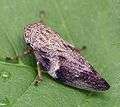Aphrophora alni
| Aphrophora alni | |
|---|---|
 | |
| Aphrophora alni, side view | |
| Scientific classification | |
| Kingdom: | Animalia |
| Phylum: | Arthropoda |
| Subphylum: | Hexapoda |
| Class: | Insecta |
| Order: | Hemiptera |
| Suborder: | Auchenorrhyncha |
| Infraorder: | Cicadomorpha |
| Superfamily: | Cercopoidea |
| Family: | Aphrophoridae |
| Genus: | Aphrophora |
| Species: | A. alni |
| Binomial name | |
| Aphrophora alni (Fallén, 1805) | |
Aphrophora alni, the 'European Alder Spittle Bug', is a species belonging to the family Aphrophoridae.
This large 'froghopper' is quite common and widespread. It is present in most of Europe, in eastern Palearctic ecozone, in the Near East and in North Africa.

The adults reach 9–10 millimetres (0.35–0.39 in) of length, the females are usually slightly larger than the males. They can be encountered from May through October on bushes and on several species of trees, especially willows (Salix species), birch (Betula species), alder (Alnus species) and poplar (Populus species).). They inhabit dry and moist habitats of lowlands and mountainous areas, forest edges, hedgerows, meadows, gardens and parks.
The basic coloration of the body is usually brown. Their front wings wear two distinct clear patches on the margins. Head and pronotum have a median keel. The head has a pair of compound eyes and two simple eyes (ocelli). The legs are strongly developed and fit to jump. Tibiae of the rear pair of legs carry several spines.
Aphrophora alni is a polyphagous species, meaning it feeds on several kind of plants. The adults primarily feed on deciduous trees, while larvae prefer herbaceous plants (dicotyledonous).
To lay eggs, the females migrate to the herb layers. The eggs overwinter and hatch the larvae in the following Spring. The larvae live in stems and leaves of herbaceous plants inside the typical foam nest, that protects them against enemies and provide necessary moisture and temperature for their development. Aphrophora alni has only one generation a year.
External links
-

-
.jpg)
-

-

Mating